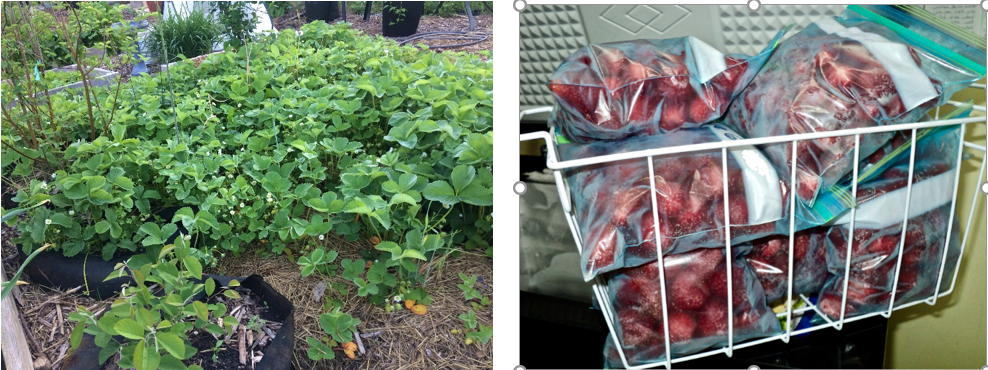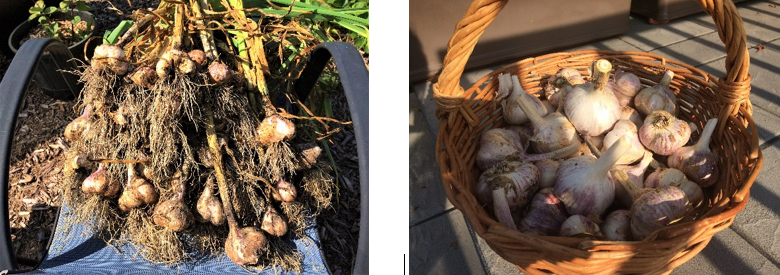|
In the forest garden, things started happening right from the start, rewarding all our senses. White clover popped up through the wood chips, a remnant from the old lawn that was once in our back yard. I was happy to see it and even happier to see it spread into a stepable, hardy mat. No other weeds grow in it and I see bees enjoying its nectar even as late as November. It is and will continue to transmit atmospheric nitrogen into the soil which nourishes my fruit trees. I plan to spread it around other trees. During my flash visits in the garden I would nourish on asparagus, lettuce, purslane and daylily flowers, I would taste-test various berries all growing on their own without any of my help. Not all crops succeeded but there was enough variety to allow me plenty to enjoy. While my forest garden develops there is still plenty of abundance. In the months of May and June we enjoyed an almost daily harvest of beyond organic, freshly cut baby kale and baby spinach from these two 4x4' raised beds tucked in the back corner of my food forest. While the fruit trees are still too young to bare fruit, I enjoy the fastest fruiting plants – the berries! I tasted plump, blushing gooseberries for the first time and found them to be surprisingly delicious. The exceptionally rainy season produced the largest and sweetest blueberries I had ever harvested and the ever- expanding carpet of everbearing strawberries produced juicy, sweet strawberries. Some developed botrytis (grey mold) due to the constant moisture but enough were left untouched and a few litres are still stored in the freezer. Black raspberries, I had heard about them and finally got the chance to taste their sweet and pleasing taste. Trying different cultivars, I grow red, yellow and black raspberries, Red, white and black currants, five varieties of blueberries, honeyberries, gooseberries and three varieties of strawberries. One variety I planted among a perennial garden some years ago and it has finally spread and produced abundant fruit. One other berry is the mother of all herbal medicines and superfoods – seabuckthorn. Going into it’s 3rd year I am expecting its first Orangy-golden crop by next summer. Even serviceberries were abundant and they were also stored in the freezer. I decided to save them for something special and that occasion did come to my excitement. I will tell you about that later. I quickly cut off all the garlic scapes, they are the flower stem of the garlic plant and made them into pesto and froze it in many small portions. Removing the scapes sends more energy into the bulb for its development. Soon after, I quickly harvested five baskets full of garlic heads! They will last us until next harvest and beyond. I make a new Caesar salad dressing with creamed almonds and roasted garlic that is better than any Caesar sauce I had ever tasted. Now we can roast garlic as much as we want. Also, basil was abundant, especially the ones grown in containers and pesto was quickly ground and frozen for latter use. As a full-time student, I need quick, accessible and satisfying food. The pesto spreads are tasty and nutritious and I enjoy them on and with everything I eat. Oh, I promised to tell you about the serviceberries: I made a 100 % traditional indigenous meal together with my friend Laura Schultz to share with co-students and with our amazing teacher Teri Sherwood. It gave me the golden opportunity to use my stored serviceberries. We chose to make a pudding to go alongside a wild rice salad. T’was a-mazing! And super easy to make. Serviceberry, Amelanchier canadensis is my #1 best recommended small tree to plant in the urban garden. Here is the recipe for the saskatoon (serviceberry) pudding, it is taken from the Dietitians of Canada website: Saskatoon Berry Pudding 2 cups serviceberries (AKA saskatoon berries) ½ cup maple syrup 1 ½ cups water plus ½ cup water ½ cup corn flour or any other flour (corn flour is authentic to indigenous cultures in our area.) Combine berries, 1 ½ cup water and maple syrup in a medium size pot and bring to a boil. Lower heat and simmer for about 15-20 minutes. Place the flour inside a small bowl and add ½ cup water. Mix well. Add the flour mixture to the berries and cook on low heat stirring it well for about 10 minutes or until thickened. Move to a glass jar and let cool. With loving harvests,
Sharona References: Canadian Home Economics Foundation, Aboriginal Nutrition Network, Dietitians of Canada. (2016). Notes From The Dietitian. Retrieved from: https://www.dietitians.ca/Downloads/Public/08---Recipes/10-Saskatoon-Pudding.aspx
0 Comments
Leave a Reply. |
Sharona GorenAvid gardener. Experimenter. Striver. Nature lover. Seeker. Archives
December 2022
Categories |
Site powered by Weebly. Managed by Netfirms





 RSS Feed
RSS Feed